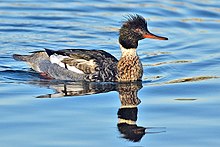Mergus
| Typical mergansers | |
|---|---|
 | |
| Red-breasted Merganser (Mergus serrator) | |
| Scientific classification | |
| Kingdom: | Animalia |
| Phylum: | Chordata |
| Class: | Aves |
| Order: | Anseriformes |
| Family: | Anatidae |
| Subfamily: | Merginae |
| Genus: | Mergus Linnaeus, 1758 |
| Species | |
Mergus australis (extinct)
Mergus merganser Mergus octosetaceus Mergus serrator Mergus squamatus | |
Mergus is the genus of the typical mergansers, fish-eating ducks in the seaduck subfamily (Merginae). The Hooded Merganser, often termed Mergus cucullatus, is not of this genus but closely related. The other "aberrant" merganser, the Smew (Mergellus albellus), is phylogenetically closer to goldeneyes (Bucephala).
Although they are seaducks, most of the mergansers prefer riverine habitats, with only the Red-breasted Merganser being common at sea. These large fish-eaters typically have black-and-white, brown and/or green hues in their plumage, and most have shomewhat shaggy crests. All have serrated edges to their long and thin bills that help them grip their prey. Along with the Smew and Hooded Merganser, they are therefore often known as "sawbills". The goldeneyes, on the other hand, feed mainly on mollusks, and therefore have a more typical duck-bill. They are also classified as "divers" because they go completely under-water in looking for food. In other traits, however, the genera Mergus, Lophodytes, Mergellus, and Bucephala are very similar; uniquely among all Anseriformes, they do not have notches at the hind margin of their sternum, but holes surrounded by bone.
Species
- †Auckland Merganser, Mergus australis (extinct, c.1902)
- Common Merganser or Goosander, Mergus merganser
- Brazilian Merganser, Mergus octosetaceus
- Red-breasted Merganser, Mergus serrator
- Scaly-sided Merganser, Mergus squamatus
Some fossil members of this genus have been described:
- †Mergus miscellus is known from the Middle Miocene Calvert Formation (Barstovian, c.14 million years ago) of Virginia, USA.
- †Mergus connectens lived in the Early Pleistocene about 2–1 million years ago, in Central and Eastern Europe.
The Early Oligocene booby "Sula" ronzoni was at first mistakenly believed to be a typical merganser. A Late Serravallian (13–12 million years ago) fossil sometimes attributed to Mergus, found in the Sajóvölgyi Formation of Mátraszõlõs, Hungary, probably belongs toMergellus. The affiliations of the mysterious "Anas" albae from the Messinian (c.7–5 million years ago) of Hungary are undetermined; it was initially believed to be a typical merganser too.
No comments:
Post a Comment